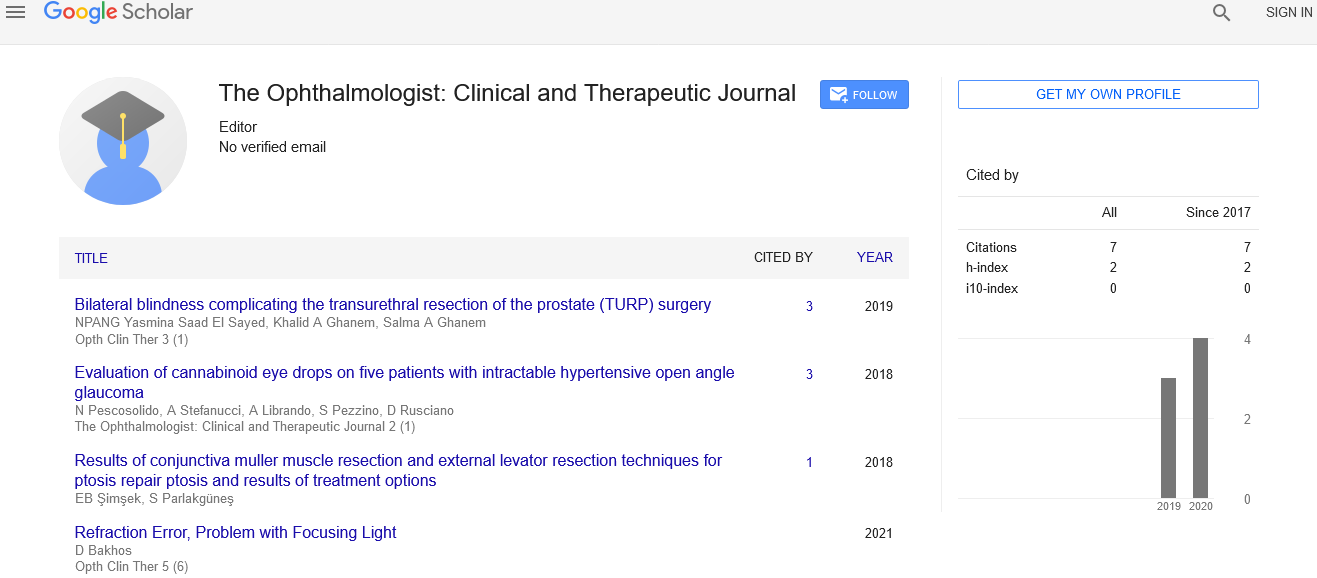Ampleness of separation techniques & capability of extending LESCs from tissues
Received: 10-Jan-2022, Manuscript No. PULOCTJ-22-4234; Editor assigned: 12-Jan-2022, Pre QC No. PULOCTJ-22-4234(PQ); Accepted Date: Jan 12, 2022; Reviewed: 18-Jan-2022 QC No. PULOCTJ-22-4234; Revised: 21-Jan-2022, Manuscript No. PULOCTJ-22-4234(R); Published: 11-Feb-2022, DOI: DOI:10.37532/puloctj.22.6.1.1
Citation: Wang N. Ampleness of separation techniques & capability of extending LESCs from tissues. Opth Clin Ther. 2022;6(1):1.
This open-access article is distributed under the terms of the Creative Commons Attribution Non-Commercial License (CC BY-NC) (http://creativecommons.org/licenses/by-nc/4.0/), which permits reuse, distribution and reproduction of the article, provided that the original work is properly cited and the reuse is restricted to noncommercial purposes. For commercial reuse, contact reprints@pulsus.com
Abstract
The transplantation of extensions of Limbal Epithelial Foundational Microorganisms (LESC) stays one of the most proficient treatments for the treatment of Limbal Undifferentiated Cell Inadequacy (LSCD) until now. Be that as it may, the accessible giver corneas are scant, and the corneas preserved for long time, under hypothermic circumstances (following 7 days) or in culture (over 28 days), are generally disposed of because of helpless feasibility of the endothelial cells. To lay out a true rule for the use or disposing of corneas as a wellspring of LESC, we portrayed, by immunohistochemistry investigation, giver corneas rationed in various circumstances and for various timeframes. Cell populaces secluded from benefactor corneoscleral tissues were likewise surveyed in light of these markers to confirm the ampleness of separation techniques and the capability of extending LESCs from these tissues. Inspiration for quite some time foundational microorganism markers like CK15 and p63α was distinguished in all corneoscleral tissues, albeit a decline was recorded during the ones preserved for longer times. The obstruction work and the capacity to stick to the extracellular grid were kept up with in every one of the investigated tissues.
Key Words
Limbal epithelial cells, cornea, corneoscleral tissues, LSCD
Introduction
Corneal visual impairment is assessed to influence 23 million individuals around the world. In any case, because of the lack of corneal contributors, just 1 out of 70 necessities can be covered. A populace of Limbal Epithelial Foundational Microorganisms (LESCs) is liable for the support of a solid corneal epithelium all through life by continually providing girl cells, which relocate centripetally towards the focal cornea to supplant lost cells and separate as they progress from the basal to shallow epithelial layers. LESCs dwell in the basal layer of the epithelium inside the corneal limbusthe vascularised and profoundly innervated line between the focal cornea and conjunctiva. All the more explicitly, the limbal tombs the descending invaginations of the limbal epithelium into the limbal stroma between the palisades of Vogt-have been proposed as the LESC specialty. During LESC disappointment, the conjunctiva can attack the cornea, causing constant irritation, corneal murkiness, vascularisation and serious inconvenience, which can prompt visual impairment. Current medicines for LESC lack depend upon transplantation of allogenic or autologous limbal societies. Refined LESC conveyance is one of a few instances of a fruitful grown-up undeveloped cell treatment utilized in patients, which accomplishes super durable rebuilding of harmed tissues in 76% of cases. The quantity of immature microorganisms present in a limbal biopsy is in the request for hundreds and this number increments during the essential culture because of the enhancement of the first undifferentiated cell populace.
Result
The outcomes acquired showed the normal staining examples of both cytokeratins in all new corneoscleral tissues regardless of the various long periods of protection. The statement of Creatine Kinase (CK12) was restricted to the suprabasal regions all through the fringe corneal epithelium. Its explicitness diminished in tissue areas got from corneoscleral tests moderated for a more drawn out time frame. The fluorescence example of CK15 was restricted to the basal region of the limbal and conjunctival epithelium. To notice the potential distinctions in CK15 staining between gatherings, a quantitative investigation of the CK15-stained region in examined corneoscleral edge segments was performed. The staining design was evaluated in the conjunctiva, limbus and fringe cornea. The outcomes showed a diminishing CK15 staining pattern in the limbal region as the preservation season of the corneoscleral tissues expanded from 2 to 8 days. In any case, its appearance expanded in the tissue at 9 days of preservation. The corneoscleral edges preserved for 1 day (pmt>16 h) and the ones refined for 29 days were excluded from the measurable examination because of changes in the markers’ looks. the outcomes connected with vimentin naming recommended the requirement for a more thorough review to figure out which cell type relates to the inspiration of this marker in the corneal limbal epithelium, which would assist with explaining the particular cells living in the limbus and their collaborations with the limbal stem/begetter cells. The comprehension of their conduct could assist with growing new culture conditions that would protect the aggregate and capacity of the limbal stem/ancestor cells, before their utilization for treatment of limbal undifferentiated organism sicknesses. We have shown that the leftover limbal edges after corneal transplantation, which had been rationed in hypothermic circumstances for up to 7 days and ought to ordinarily have been disregarded, can be an important wellspring of LESC societies for research and in any event, for undifferentiated organism treatment.





